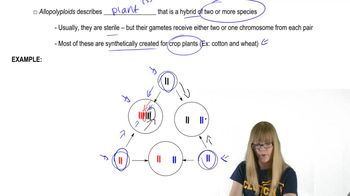Here are the essential concepts you must grasp in order to answer the question correctly.
Allopolyploidy
Allopolyploidy is a form of polyploidy that occurs when two different species hybridize, resulting in a new species with multiple sets of chromosomes from both parents. In this case, the new allopolyploid plant species has a chromosome number of 36, which is the sum of the chromosome sets from the two diploid parents (14 + 22). This genetic makeup can lead to unique traits and adaptations but also complicates reproduction with the parent species.
Recommended video:
Chromosome Compatibility
Chromosome compatibility is crucial for successful sexual reproduction. For an allopolyploid to produce fertile offspring with its diploid ancestors, the chromosome numbers must align properly during meiosis. In this scenario, the allopolyploid has 36 chromosomes, while the diploid parents have 14 and 22 chromosomes, respectively. This significant difference in chromosome number can lead to issues during gamete formation, often resulting in sterile progeny.
Recommended video:
Fertility and Hybridization
Fertility in hybridization depends on the ability of the hybrid organism to undergo meiosis and produce viable gametes. In many cases, hybrids between species with differing chromosome numbers are sterile due to improper pairing of chromosomes during meiosis. Given that the allopolyploid has a different chromosome count than its diploid ancestors, it is unlikely that sexual reproduction would yield fertile progeny, as the genetic mismatch can hinder successful gamete formation.
Recommended video:






